There are two major types of gorillas – the western and eastern gorillas. Western gorillas are further divided into two subspecies – the western lowland gorilla (also known as gorilla gorilla) and the Cross River gorilla found in Cameroon and Nigeria. Eastern Gorillas are divided into two subspecies – Eastern Lowland Gorilla (Grauer’s gorilla) and Mountain gorillas. Western lowland gorillas are the smallest but most numerous of all the four gorilla subspecies.
It is believed the over 360,000 western lowland gorillas live in the vast swamps and forests of West and Central Africa. Western lowland gorillas survive well in captivity and over 550 individuals are found in zoos around the world.
Facts about Western Lowland Gorillas
Western lowland gorillas are found in the swamps and forests of central Africa – Gabon, Republic of Congo, Central African Republic, Equatorial Guinea, Angola and Cameroon. Most Western lowland gorilla populations are found in the forests of the Republic of Congo. Almost all gorillas found in captivity or zoos are western lowland gorillas. They may be the smallest of all the gorilla subspecies, but an adult can weigh up to 270 kilograms in the wild and more in captivity. They have been known live up to 40 years in the wild and 60 in captivity.
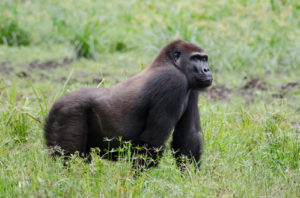 Western lowland gorillas are very social primates that depend on their group to thrive. Gorilla groups are led by a dominant Silverback. Silverback gorillas display great charisma and a sense of intelligence. A male silverback can reach 5 feet and 1 inches when standing erect. Although they weigh about the same size as an adult male human, gorillas are seven times stronger. Like all gorilla subspecies, they have no tails. Rough hair covers their whole body except for the hands, feet, ears and face. Male gorillas can also be distinguished by the silver hair on their back.
Western lowland gorillas are very social primates that depend on their group to thrive. Gorilla groups are led by a dominant Silverback. Silverback gorillas display great charisma and a sense of intelligence. A male silverback can reach 5 feet and 1 inches when standing erect. Although they weigh about the same size as an adult male human, gorillas are seven times stronger. Like all gorilla subspecies, they have no tails. Rough hair covers their whole body except for the hands, feet, ears and face. Male gorillas can also be distinguished by the silver hair on their back.
Western Lowland gorillas are highly intelligent primates. They can turn all sorts of materials into tools to help them get food or even measure the depth of a river before crossing. They have shown a remarkable ability to understand simple sign language while in captivity. The level of intelligence of an adult gorilla is thought to be at the same level as that of a human child.
Feeding habits of Western Lowland gorillas
Lowland gorillas are primarily herbivorous primates and spend most of the day eating with only one break at midday. Adults use the midday rest to take a nap while the young paly among themselves. Their diet is mostly made of shoots, fruits, pulp, wild berries, tree bark and roots. Some of the food eaten are staple foods while others are consumed depending on the season of the year and shifting rains. An adult western lowland gorilla can eat up to 18 kilograms of food in a day. They don’t have to move far away in search of food like other primates since lost forest and vegetation cover grow rapidly. On average, Western lowland gorillas move for about 4 kilometers every day in search of food.
Nesting, Behavior and Social structure of Western lowland gorillas
Like other gorilla subspecies, Western lowland gorillas live in groups. A group usually contains one silverback, about three unrelated females and offerings. Unlike other gorilla subspecies, Western lowland gorillas show more tolerance towards non-relatives and gorillas from other groups. Several groups have been seen mixing freely without any aggression as they feed in open clearings with mineral 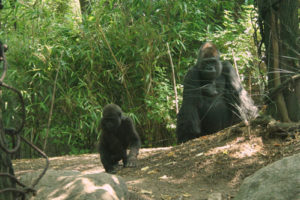 rich salts or plants. This tolerance for other gorilla groups has not been observed with other subspecies like the eastern lowland gorillas, cross river gorillas and mountain gorillas. Infanticide which is common in other gorilla sub-species is also very rare among western lowland gorillas. This is because offspring from previous dominant males have been observed living happily with their mothers even after a takeover. The dominant silverback dictates what is done in the group and will protect the group from any outside threat. The silverback determines traveling time, eating time and when to nest. Mating among western lowland gorillas is often initiated by the female once she is ovulating. Western Lowland gorillas do not control a particular territory and will migrate to different areas in search of better food. Gorillas build a nest for resting in the middle of the day and later in the evening for the night. The nest is often made up of plant material, leaves and other tree branches. Youngsters and other females may make nests on strong tree branches but the silverback sleeps on the ground to protect the family.
rich salts or plants. This tolerance for other gorilla groups has not been observed with other subspecies like the eastern lowland gorillas, cross river gorillas and mountain gorillas. Infanticide which is common in other gorilla sub-species is also very rare among western lowland gorillas. This is because offspring from previous dominant males have been observed living happily with their mothers even after a takeover. The dominant silverback dictates what is done in the group and will protect the group from any outside threat. The silverback determines traveling time, eating time and when to nest. Mating among western lowland gorillas is often initiated by the female once she is ovulating. Western Lowland gorillas do not control a particular territory and will migrate to different areas in search of better food. Gorillas build a nest for resting in the middle of the day and later in the evening for the night. The nest is often made up of plant material, leaves and other tree branches. Youngsters and other females may make nests on strong tree branches but the silverback sleeps on the ground to protect the family.
The dominant silverback forms very strong bonds with the females. This bond is important to ensure that the female do not leave the group. Female gorillas only produce offspring when they reach about 8 years of age. When the female reaches sexual maturity, they leave their family of birth to join another group or a lone silverback. This is to avoid conflicts that arise out of competing for the favors of the dominant Silverback with other females. Young males also leave the group at a certain age to avoid being considered as a threat to the dominant Silverback. The young male doesn’t necessarily join another group but can live alone or join a group of other lone males until a female chooses him to start a new family.
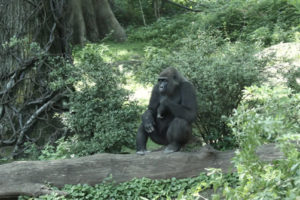 Females give birth to between four to six offspring in their lifetime. They never reach menopause. When there is a new birth, the infant depends on the mother until they reach about five years of age. Females give birth after nine months and don’t show any physical signs of pregnancy. Western Lowland Gorillas are calm and non-aggressive primates compared to chimpanzees, lions, buffaloes or most of the big five mammals. Members within a gorilla group rarely conflict or hold grudges for long like it is with chimp clans. The silverback often intervenes to make peace among the females. Aggression towards other groups is also very rare. When threatened, a silverback may pound his chest with their hands, bark, stand upright, roar frighteningly or tear up vegetation to frighten off any intruders.
Females give birth to between four to six offspring in their lifetime. They never reach menopause. When there is a new birth, the infant depends on the mother until they reach about five years of age. Females give birth after nine months and don’t show any physical signs of pregnancy. Western Lowland Gorillas are calm and non-aggressive primates compared to chimpanzees, lions, buffaloes or most of the big five mammals. Members within a gorilla group rarely conflict or hold grudges for long like it is with chimp clans. The silverback often intervenes to make peace among the females. Aggression towards other groups is also very rare. When threatened, a silverback may pound his chest with their hands, bark, stand upright, roar frighteningly or tear up vegetation to frighten off any intruders.
Threats to Western Lowland Gorillas
Western lowland gorillas face the greatest threat from humans. As human create farms and settlements closer and closer to gorilla habitats, the spread of diseases like flu has increased. Gorillas have little to no immunity against many of the human diseases and a simple flu can prove devastating and deadly to humans. Apart from the risk of disease transmission, humans hunt western lowland gorillas for bush ![]() meat, as pets or to be sold in zoos and circuses. Local medicine men/witchdoctors use their body parts for making charms. Gorillas are generally more prone to poaching because unlike chimps, they are less intimidated by humans. A silverback will stand up to poachers if they attempt to attack his family. Chimps are timid and will disappear or climb on top of trees to escape from poachers. Dominant chimps are generally not inclined to defend their group is their own life is threatened. Capturing a baby gorilla often results in the death of many of the adults in the group because they will defend their young to the death. Apart from exposure to diseases and poaching, poisoning is also a common problem among gorillas – especially in areas where they are seen as pests for going to human gardens. Perhaps the greatest threat to gorillas come from habitat loss through illegal logging and mining. Apart from destroying land degradation, illegal logging leaves gorilla groups isolated in small pockets/islands of forest which leads to inbreeding because mature females/males cannot leave the family.
meat, as pets or to be sold in zoos and circuses. Local medicine men/witchdoctors use their body parts for making charms. Gorillas are generally more prone to poaching because unlike chimps, they are less intimidated by humans. A silverback will stand up to poachers if they attempt to attack his family. Chimps are timid and will disappear or climb on top of trees to escape from poachers. Dominant chimps are generally not inclined to defend their group is their own life is threatened. Capturing a baby gorilla often results in the death of many of the adults in the group because they will defend their young to the death. Apart from exposure to diseases and poaching, poisoning is also a common problem among gorillas – especially in areas where they are seen as pests for going to human gardens. Perhaps the greatest threat to gorillas come from habitat loss through illegal logging and mining. Apart from destroying land degradation, illegal logging leaves gorilla groups isolated in small pockets/islands of forest which leads to inbreeding because mature females/males cannot leave the family.
Western lowland gorillas also face threats from global warming, leopards (rarely), crocodiles (occasionally while crossing rivers) and diseases like Ebola. An Ebola epidemic broke out at the sanctuary in Lossi between 2002 and 2003 killing almost 30 percent of the primates in the area. In 2004, there was another outbreak in Lokoué forest of Odzala-Kokoua National Park. This outbreak greatly reduced the western lowland gorilla population in the Republic of Congo. Ebola and other diseases can easily wipe out entire populations because western lowland gorilla groups interact among themselves compared to other gorilla sub-species.
Why are western lowland gorillas more prone to poaching and many of the threats already mentioned? It is important to note that western lowland gorillas live in many of the countries most affected by civil wars and unrest in Africa. Although hunting gorillas is illegal throughout the world, poor management and corruption weakens implementation of regulations. Mountain gorillas are relatively not affected by some of the problems faced by their cousins because of the strict policies in place in Uganda and Rwanda.
Note: It is widely believed that HIV/AIDS originated from western lowland gorillas. This is because Simian immunodeficiency virus (SIV) which is found in some western lowland gorillas and chimpanzees is similar to certain strains of HIV-1. There is a believe that the virus mutated and found its way in humans through the eating of bush meat.
Western Lowland Gorilla Conservation
Because of the devastating Ebola outbreaks among western lowland gorilla populations, the International Union for Conservation of Nature (IUCN) was forced to declare Western lowland gorillas critically endangered despite their considerable numbers. Countries in Africa with support from gorilla conservation organizations like the Wildlife Conservation Society (WCS), World Wide Fund for Nature (WWF) and Zoos worldwide, have swiftly responded to the threats faced by western lowland gorillas. WCS works closely with communities in the Congo Basin to promote gorilla and other wildlife conservation activities. They help enforce laws and other restrictions that help stop trade in bush meat. WCS also helps the communities living close to the primates find alternative food.
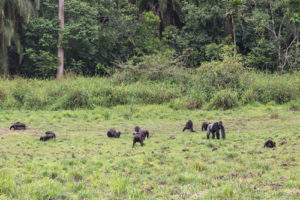 WWF started an African Great Apes Programme to help in the conservation of all gorilla sub-species through strengthening protected areas, supporting gorilla tracking programs, promoting sustainable development and coming up with an Ebola Vaccine. The programme is very active in Dzanga Sangha Protected Area of Central African Republic, Lobeke National Park in Cameroon and Nouabale-Ndoki National Park of the Republic of Congo. The programme is also supported by the WCS, World Bank, GTZ, the French Cooperation and USAID. Apart from WCS and WWF, the Bristol Zoological Society supports several gorilla conservation projects in Africa and are active in Dzanga-Sangha (Central Africa Republic), Mefou National Park (Cameroon) and Monte Alén National Park (Equatorial Guinea). The society funds research activities, training of personnel in national parks and other law enforcement activities. The Cincinnati Zoo has also dedicated funding towards gorilla conservation in both zoos and in the wild.
WWF started an African Great Apes Programme to help in the conservation of all gorilla sub-species through strengthening protected areas, supporting gorilla tracking programs, promoting sustainable development and coming up with an Ebola Vaccine. The programme is very active in Dzanga Sangha Protected Area of Central African Republic, Lobeke National Park in Cameroon and Nouabale-Ndoki National Park of the Republic of Congo. The programme is also supported by the WCS, World Bank, GTZ, the French Cooperation and USAID. Apart from WCS and WWF, the Bristol Zoological Society supports several gorilla conservation projects in Africa and are active in Dzanga-Sangha (Central Africa Republic), Mefou National Park (Cameroon) and Monte Alén National Park (Equatorial Guinea). The society funds research activities, training of personnel in national parks and other law enforcement activities. The Cincinnati Zoo has also dedicated funding towards gorilla conservation in both zoos and in the wild.
How can you help? As an individual, you can support gorilla conservation activities by visiting western lowland gorillas. Money from gorilla tourism in Africa goes a long way in helping fund conservation activities. As communities living close to gorilla habitats see the benefits of gorilla tourism, they are less likely to participate in or condone in poaching. You can also donate or adopt a gorilla through zoos or the WWF. Finally, you can also support gorilla conservation initiatives by simply spreading the word among your circle of friends.
Western Lowland Gorilla Trekking
Are you wondering where to see western lowland gorillas in the wild? Perhaps you have already seen them numerous times in zoos and wish to see them in the African wild. Wild western lowland gorillas can be seen at the Odzala National Park in Congo Brazaville, Léfini Reserve in Congo Brazaville, 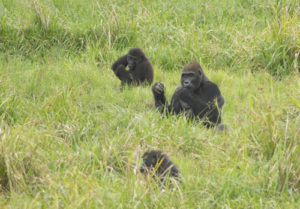 Moukalaba-Doudou National Park in Gabon, Lopé National Park in Gabon, Loango National Park in Gabon, Dzanga-Ndoki National Park in the Central African Republic, Monte Alen National Park in Guinea and Cabinda enclave in Angola. Western lowland gorilla trekking is more challenging than tracking mountain gorillas. It involves traveling longer distances into extremely remote parts of Africa. You need to prepare to walk for long hours through dense forest in search of the gorillas. The chances of seeing mountain gorillas is higher than that of western lowland gorillas. This is because most western lowland gorilla groups live in far more remote forests – some of which have never been fully discovered by man. Most western lowland gorillas are not habituated. The only way to see them without scaring them off is to stay in hidden enclosures and wait for them to come out to a clearing. You can read more from the article about the best places to see gorillas in Africa.
Moukalaba-Doudou National Park in Gabon, Lopé National Park in Gabon, Loango National Park in Gabon, Dzanga-Ndoki National Park in the Central African Republic, Monte Alen National Park in Guinea and Cabinda enclave in Angola. Western lowland gorilla trekking is more challenging than tracking mountain gorillas. It involves traveling longer distances into extremely remote parts of Africa. You need to prepare to walk for long hours through dense forest in search of the gorillas. The chances of seeing mountain gorillas is higher than that of western lowland gorillas. This is because most western lowland gorilla groups live in far more remote forests – some of which have never been fully discovered by man. Most western lowland gorillas are not habituated. The only way to see them without scaring them off is to stay in hidden enclosures and wait for them to come out to a clearing. You can read more from the article about the best places to see gorillas in Africa.
